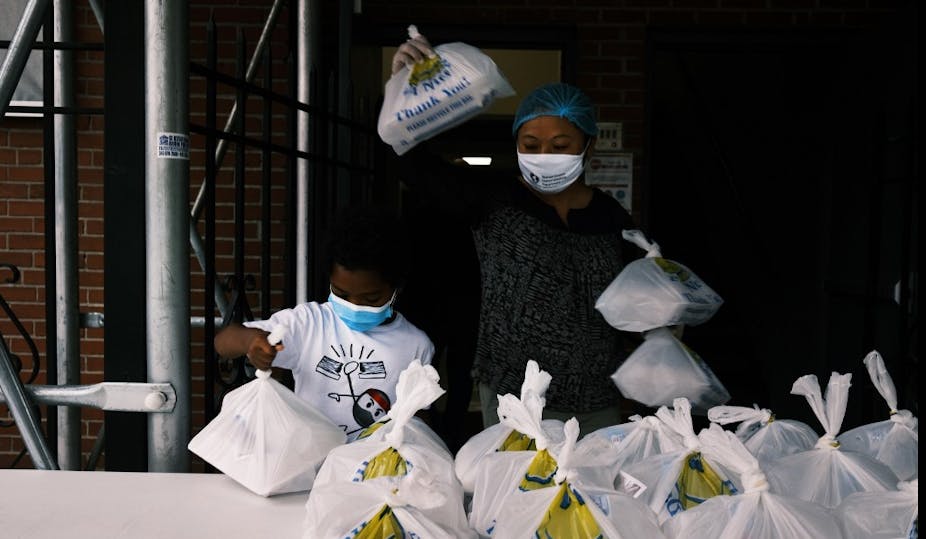During the first televised presidential debate and on several occasions during the campaign, President-elect Joe Biden stated that during Donald Trump’s time in office, the United States became poorer, weaker and more violent.
Biden’s assertions about poverty are based on a University of Columbia study that analyzed and modeled the monthly poverty rate of American families before, during and after the Covid-19 pandemic. The results indicate that, even in a best-case scenario, the monthly poverty rate increased from 15% to 16.7% between February and September 2020. In other words, poverty is on the rise, and has risen considerably since Trump took office in January 2017 due to the unprecedented health crisis that has struck countries throughout the world.
Multiple definitions of poverty
At the same time, it is important to remember that there is no international consensus about the definition of poverty. The two major organizations, the World Bank and the United Nations Development Program, agree on the causes of poverty but not on its definition. The former uses a monetary approach, focusing on the level of income needed to sustain one adult. Monetary poverty is defined as a level of consumption of less than $1.90 per day. The latter uses three notions: extreme poverty, meaning insufficient income to cover basic nutritional needs, defined as a minimum number of required calories (1,800 calories per person per day according to the WHO); general poverty, relating to basic, non-nutritional needs; and human poverty, defined according to indicators such as illiteracy, poor maternal health, preventable diseases and so on.
Access to resources is the common denominator in these definitions. More resources mean less poverty. In the United States, the Census Bureau provides poverty data. Let’s consider how poverty rates changed under Donald Trump, based on these various definitions.
Trump took office during an economic expansion
Prior to Trump’s taking power, unemployment had risen spectacularly during the 2008 financial crisis, which took place at the end of George W. Bush’s presidency and lasted into the beginning of Barack Obama’s first term. After 2012, it dropped steadily. Of course, unemployment means fewer resources.
Obama’s record was marred by the financial crisis he inherited (3.3 million more people were impacted), an opioid epidemic in rural areas and an inability to control rising healthcare costs, despite the passage of the Affordable Care Act. Poverty rose across demographics but African Americans, who are 10 times poorer than whites, were the hardest hit, further exacerbating inequalities. Among the poorest populations, life expectancy dropped, due to factors such as suicide, overdose, alcoholism and violent crime.

When Trump took office in January 2017, the American economy was back on track. The country had entered a period of expansion that would be described as the longest in its history. In December 2019, unemployment was at 3.5%, its lowest rate in half a century. Yet in the same year, the poverty rate in the United States was around 18%, with the Organization for Economic Co-operation and Development (OECD) ranking the United States fourth on its poverty rate index. At the time, more than one in ten Americans suffered from food insecurity and 37 million Americans resorted to federal food assistance for low- and no-income people. This instability was largely due to the fact that half of all American households do not have sufficient savings to deal with unexpected expenses.
Increased inequality is harder on minorities
What was the impact of the Covid-19 pandemic? According to a 2020 study by the Urban institute, rising poverty in the United States did not impact all Americans equally. In households where at least one person lost his/her job due to the health crisis, the rate of poverty between August and December is estimated at 15.6%, as compared to the annual projected rate of 9.1%. African American and Hispanic households with at least one job loss were disproportionately affected: the poverty rate in these communities should be close to 20% for the August-December period 2020, deepening disparities.

According to Feeding America, the largest network of food banks in the United States, nearly one in six Americans suffered from food insecurity in 2020, including 18 million children. The network reported that 98% of its distribution outlets have seen a rise in demand since the beginning of the crisis, in March 2020, and 37% are facing imminent resource shortages. The study on which Joe Biden bases his assertions also indicates that the increase in poverty rates is higher among African Americans, Hispanics and children.
The government assistance and unemployment payments set out in the CARES act, the relief plan adopted in March 2020, enabled over 18 million people to escape monthly poverty in April, but this figure dropped to around 4 million people in August and September after additional aid for the unemployed expired. Since these measures were not extended, the monthly poverty rate was higher in September 2020 than at the start of the year.
The United States is undoubtedly poorer at the end of Donald Trump’s time in office. Having undermined its social safety net, the president deprived the country of crucial weapons in the fight against poverty, at a time when an unprecedented health crisis set it soaring.
This article was written in collaboration with Ons Kaabia, University of Sousse, Tunisia; Farhat Hached, Sousse Faculty of Medicine; and Laura Alliche and Paul Boyer, Tours University Public School of Journalism (EPJT). It was translated from the French by Alice Heathwood for Fast ForWord.
The Fact check US section received support from Craig Newmark Philanthropies, an American foundation fighting against disinformation.


